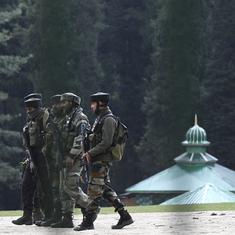It was a bright winter morning on the eleventh moon of Naiwieng when Nongbah first noticed the strange transformation of Manik.
Nongbah was the capital of Hima Mokkhiew, the state of Mokkhiew in Ri Bhoi, one of the most powerful states in Ri Hynñiew Trep, or Khasi Land, in those days, hundreds of years before the coming of the Ahoms to Assam. It was located on a vast expanse of flat land, almost unimpeded except for low hills in the distance to the east and south, and an extensive forest in the north and north-east. The north-eastern part of the forest was sanctified as a sacred grove, and it was there that the hima’s priests performed all the religious rituals of the state. Beyond the forest to the north-west were more hills, quite thickly wooded. In the south-west were paddy fields, and beyond them was a large plateau partly covered with tall trees. The hills to the east and south did not form an extended range but rose from the plain in clusters as if someone had planted them there. And all of them were barren, except for the wooded areas between the folds. Little streams flowed towards the town in a northerly direction from these thickets.
There were no signs of fortification anywhere – only observation posts in the hills, for the town was protected by well-fortified villages in the outlying districts.
The town’s houses were mostly made of bamboo and thatch for the poor and wood and thatch for the well-to-do. Between the houses could be seen, if you stood on one of the low hills, a network of dirt lanes and by-lanes criss-crossing like the lines in a person’s palm. Two great pathways intersected the town precisely in the middle, making it appear like a carefully planned settlement. One of the pathways ran north to south, cutting through the forest; the other ran east to west. The weekly market and most of the shops were situated around the intersection – known as Sawlad, the town square and the commercial hub.
When Manik showed up, the sun was already high above the low hills on the eastern fringe. The townspeople were busy with their morning chores, making all those morning noises so common to country life everywhere, for Nongbah, like all Khasi towns in those days, was essentially an enormous village where farming and the rearing of domestic animals like chickens, pigs, goats and cattle, combined with manufacturing activities needed to support an agrarian economy or to meet the requirements of defence and trade. It was the clamour of the children that drew them away from whatever they were doing to come and stare at the spectacle Manik was making of himself.
Some of them had come running from as far away as the forest. The forest had numerous springs used as drinking water sources by those in the northern and north-western localities. A section of it, far from the springs and the pathway, was used for morning purposes to answer urgent calls of nature. For additional cleaning functions, pigs, roaming freely everywhere, were used as scavengers.
At Lyngkien’s pata, they also heard the children’s clamour. Lyngkien’s pata was the biggest of the local booze joints. Like many of the shops, it was also located in Sawlad – on the left side of the pathway heading west, to be precise. It was a low building with a wooden frame, a wooden wall and a thatch roof, all blackened by wood smoke. It had a wide veranda with low wooden stools placed against the wooden wall.
Lyngkien Makri, the owner, Ailin Makri, her ward, and two of her respected customers, Shemphang Nongbet and Kynih Khymdeit, were sitting on the veranda. Ailin was cleaning some vegetables. Lyngkien had a shangkwai, or betel nut basket, on her lap. She was peeling betel nuts while chatting with Shemphang and Kynih, who were nursing a bamboo mug of rice beer – yiad um – in their hands. But most of her other customers, including Sapho and his friends, were lying about on the spacious, grass-covered yard in front of the hut. The grass was short and brown, and for that reason, all the more inviting for a morning in the sun. It was indeed a pleasant morning – not cold, though it was winter; not hot, because it was winter.
Like all Khasi women of the time, the lovely Lyngkien was dressed in a cotton cloth called jympien, wound over the body and tied at the waist with a strip of cloth. Above her jympien, which fell to her ankles, she wore a sopti-kti, a kind of blouse, and over it, a long outer garment called jaiñsem draped from the shoulder. She did not use her red-and-black checked tapmoh khlieh shawl but kept it folded on one of the stools on the veranda. Ailin, a beautiful, plump woman in her early twenties, was dressed likewise. Among the men, only the rich merchant, Shemphang, was dressed slightly differently. While all the others wore white cotton dhotis, white cotton shirts and dark grey or dark blue sleeveless woollen jackets, his dhoti and turban were colourful and expensive.
When Lyngkien and her customers heard the shouts of the children growing louder, they all rushed towards the pathway to see what was happening. It was Manik, followed by a large group of children, jeering at him, throwing stones and calling him, “Madman! Madman!”
The tall, wiry Manik was bareheaded and barefoot. He had clothed himself in a dhoti and loose cape fashioned from a tattered sackcloth, heavily covered with dust and ash. But that was not all. He had anointed himself from head to foot with ash and even smeared his face with soot. That was why people thought he had gone stark, raving mad. Many said he looked like a filthy pauper, a ragged vagrant, a dirty scoundrel.
More and more people came out to watch the strange spectacle. But Manik was oblivious to everything as he went along the westbound pathway, blowing on a long, slender pipe that he had carved from seasoned shken, the small-stem bamboo.
As he went past Lyngkien’s pata, Sapho, looking like an upright chicken with his bloated stomach and thin legs, and the other drunks there, mostly scrawny like him, called out derisively.
“Look! It’s Manik!” they shouted. “What is he doing? Why is he making such a strange spectacle of himself? What’s wrong with him?”
“Ei, Manik! Why are you dressed in sackcloth?” Sapho asked. “What has happened to you? Why have you smeared yourself with ash?”
“And what is that thing you are blowing on?” a drunk named Lit added.
“I know, Lit, I know,” Sapho shouted. “He’s planning to become a fakir, isn’t that right, Manik? Or is it one of those snake charmers from the plains?”
Manik walked on without responding. He seemed lost in his own world, playing his strange musical instrument.

Excerpted with permission from The Distaste of the Earth, Kynpham Sing Nongkynrih, Penguin India.










